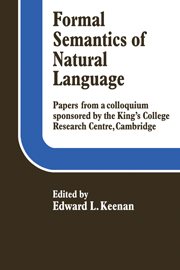Book contents
- Frontmatter
- Contents
- Notes on the contributors
- Acknowledgements
- Introduction
- I QUANTIFICATION IN NATURAL LANGUAGE
- II REFERENCE AND CROSS REFERENCE
- III INTENSIONAL LOGIC AND SYNTACTIC THEORY
- Two theories about adjectives
- Partial interpretations
- Subcategorization of adnominal and adverbial modifiers
- Should generative semantics be related to intensional logic?
- Transformational semantics
- IV QUESTIONING MODEL THEORETIC SEMANTICS
- V PRAGMATICS AND SENTENCES IN CONTEXT
- VI SEMANTICS AND SURFACE SYNTAX
Should generative semantics be related to intensional logic?
Published online by Cambridge University Press: 05 November 2011
- Frontmatter
- Contents
- Notes on the contributors
- Acknowledgements
- Introduction
- I QUANTIFICATION IN NATURAL LANGUAGE
- II REFERENCE AND CROSS REFERENCE
- III INTENSIONAL LOGIC AND SYNTACTIC THEORY
- Two theories about adjectives
- Partial interpretations
- Subcategorization of adnominal and adverbial modifiers
- Should generative semantics be related to intensional logic?
- Transformational semantics
- IV QUESTIONING MODEL THEORETIC SEMANTICS
- V PRAGMATICS AND SENTENCES IN CONTEXT
- VI SEMANTICS AND SURFACE SYNTAX
Summary
As far as I know there has been no attempt to relate generative semantics (GS) to intensional logic (IL) in a complete and systematic manner. Indeed at first sight one may well doubt that a relation can be established at all. So the first question we shall be concerned with here is with which parts of the theory of GS one should try to establish such a relation. And the second will be with which methods should be used.
If both theories could be formulated as formal, or mathematical theories, then we could try to construct mappings between them. As Montague (1970b) has shown, intensional languages and intensional logic can be formulated as mathematical theories. But I know of no formalization of GS.
Another systematic way to attack this problem is reduction, which means roughly, the embedding of one theory into another. This can be done for parts of theories as well and it is that approach I shall take here. To this extent then, no complete solution to the embedding problem will be given.
It is well known that Montague's theory contains both syntax and semantics (i.e. a model theory). Concerning the syntax of GS, Partee (1972), to give one example, has formulated transformations in a Montaguetype syntax. This does not mean that the syntax or the surface structure of both theories are comparable.
Information
- Type
- Chapter
- Information
- Formal Semantics of Natural Language , pp. 188 - 204Publisher: Cambridge University PressPrint publication year: 1975
